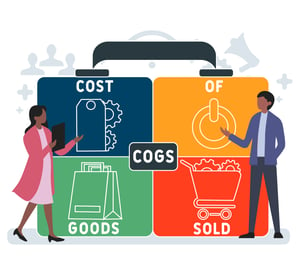In the dynamic world of e-commerce logistics, effectively managing the Cost of Goods Sold (COGS) is not just a financial exercise; it is a vital strategy that can make or break the success of your business. Understanding, monitoring, and overseeing your COGS is essential for product-based companies, especially as inventory expands and grows more complex.
From labor and material costs to manufacturing and warehousing expenses, gaining a firm grasp on your cost of goods sold metric can help streamline fulfillment and enhance cost efficiency. Let’s delve into the ins and outs of COGS and how you can utilize it to bolster your success.
Cost of Goods Sold: Why Is It Important?
So why does the cost of goods sold matter so much? Here’s the short answer: COGS directly impacts your profit margin! By taking a look at the cost of goods sold, your business can determine what the actual costs of producing your merchandise are. When equipped with these insights, you can effectively price out items in a manner that will generate revenue.
By understanding the importance of COGS, your business is able to price items intelligently, ensuring you recoup your investment without losing out on customers and repeat business. When you calculate the cost of goods sold, you’re allowing yourself to truly understand the cost of upholding an inventory, while also remaining competitive. Calculating the COGS properly can also give you insight into how to reduce spending, such as finding a cheaper supplier or other ways to optimize your profit margin.
Calculating Your Cost of Goods Sold
Determining the cost of goods sold entails monitoring inventory expenses, as well as returns and additional costs. Below, we'll explore some essential factors to consider when calculating your COGS.
- Inventory Costs: Keeping track of the cost of products and materials purchased from suppliers is a given. But identifying expenses generated from producing and storing goods, such as warehousing costs, is equally important. The most efficient way to do this is by leveraging automation and inventory management software.
- Additional Costs: When you're figuring out the costs of goods you buy or make, there are also indirect expenses you’ll incur during the order fulfillment process. These costs include things like shipping to your warehouse, packaging expenses, and transaction fees. All of these added business expenses should be woven into your overall cost of goods sold.
- Product Returns: Defective and damaged goods as well as product returns should be included in your cost of goods sold.
Strategies for Optimizing Costs of Goods Sold
Harness Technology & Automation
Leveraging technology to automate and streamline logistics processes can reduce manual labor and the costs associated with it. It can also reduce costly errors and ensure your business delivers the best customer experience possible.
AI-driven inventory management, for instance, can improve overall productivity and efficiency. This not only positively affects the cost of goods sold, but also provides your business with a competitive edge as you’ll be operating at an optimal level. By increasing your efficiency, your business can vastly improve profitability and curtail unnecessary expenses caused by human error.
Sustainable Practices
Sustainability is not just a buzzword, it’s a smart business strategy. Embracing sustainable logistics solutions not only contributes to reducing environmental impact, but also leads to long-term cost savings. By adopting greener practices, businesses can align themselves with evolving consumer expectations while optimizing their cost of goods sold. For instance, using eco-friendly packaging materials can decrease costs in the long run, as well as appeal to today’s environmentally conscious consumers. Becoming more environmentally friendly is an effective way to garner trust from your customers, as well as help set yourself apart from your competitors.
Strategic Partnerships
Collaborative approaches to logistics play a pivotal role in optimizing your cost of goods sold. Establishing a strategic partnership with a 3PL provider allows your business to access valuable resources like state-of-the-art facilities and cutting-edge technology. Partnering with a 3PL can enhance operational efficiency, reduce costs, and contribute to the overall optimization of your cost of goods sold. By outsourcing logistics to a reliable partner, businesses can focus on their core competencies while benefiting from the expertise of specialized providers.
The Smart Warehousing Advantage
Mastering the intricacies of the cost of goods sold is pivotal for driving long-term, sustainable growth for your business. The path to mastering logistics means a path to increased productivity and revenue. By leveraging the Smart Warehousing advantage, businesses can gain a competitive edge in the market, ensuring their fulfillment processes are optimized for both cost and performance. To learn more about how our team can deliver custom solutions to fit your unique needs, contact us today.


